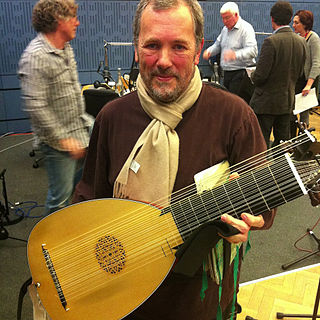
Robert Barto (born 1950's in San Diego) is an American lutenist specializing in the music of the Baroque and Empfindsamkeit periods, in particular the oeuvres of Sylvius Leopold Weiss and Bernhard Joachim Hagen.

Robert Barto (born 1950's in San Diego) is an American lutenist specializing in the music of the Baroque and Empfindsamkeit periods, in particular the oeuvres of Sylvius Leopold Weiss and Bernhard Joachim Hagen.
He is a graduate of the University of California, San Diego, having majored in historical lute performance. The recipient of a Fulbright scholarship, he continued his studies in Cologne, Germany and at the Schola Cantorum Basiliensis in Switzerland, with Michael Schäffer and Eugen Müller-Dombois, respectively. Having made Germany his home for many years, he travels and performs throughout the world.
In 1984, Barto took top honors at the "International Lute Competition" in Toronto and the competition Musica Antiqua Bruges, Belgium. His performances of note have included solo recitals at the Festival of Flanders, London's Purcell Room, the Utrecht Festival, and in New York City's "Music Before 1800" event. In 2000, Barto performed a tribute to Sylvius Leopold Weiss in Dresden. He also gave solo recitals for Bavarian Radio's "Bach Night" in Munich as well as the "Lufthansa Baroque Festival" also held in London. [1]
He is greatly sought-after as a teacher, having given master classes in Spain, Sweden, Germany, Italy and Japan. He has regularly been on the faculty of the Lute Society of America's [2] Summer Seminar series. [3]
Barto has recorded eleven volumes of lute sonatas by baroque lutenist-composer Sylvius Leopold Weiss [3] and two CDs of the solo works of Bernhard Joachim Hagen for the Naxos and Symphonia labels. [4]
Barto also recorded a part of soundtrack of an audiovisual installation by the Ukrainian artist and composer Roman Turovsky-Savchuk. [5]

A lute is any plucked string instrument with a neck and a deep round back enclosing a hollow cavity, usually with a sound hole or opening in the body. It may be either fretted or unfretted.

Sylvius Leopold Weiss was a German composer and lutenist.
Jan Antonín Losy, Count of Losinthal ; also known as Comte d'Logy, was a Bohemian aristocrat, Baroque lute player and composer from Prague. His lute works combine the French style brisé with a more Italian cantabile style. He was probably the most significant lutenist-composer in Bohemia at the height of the lute's popularity there.
A tombeau is a musical composition commemorating the death of a notable individual. The term derives from the French word for "tomb" or "tombstone". The vast majority of tombeaux date from the 17th century and were composed for lute or other plucked string instruments. The genre gradually fell out of use during the 18th century, but reappeared in the early 20th.

Roman Turovsky-Savchuk is an American artist-painter, photographer and videoinstallation artist, as well as a lutenist-composer, born in Ukraine. His musical works were published under various pseudonyms, including Johann Joachim Sautscheck.
Bernhard Joachim Hagen was a German composer, lutenist and violinist. He was the last important composer of lute music in 18th-century Germany.
Luca Pianca is a Swiss musician-lutenist whose specialty is archlute. In 1985 he co - founded Il Giardino Armonico., a pioneering Italian early-music ensemble based in Milan. He has premiered works by the contemporary lutenist-composer Roman Turovsky-Savchuk at international festivals, and received numerous international awards for his recordings.

Adam Falckenhagen was a German lutenist and composer of the Baroque period.
Terrell Stone is an American lutenist and recording artist. He is a longtime resident of Italy, where he holds the position of a Professor of lute.

Nigel North is an English lutenist, musicologist, and pedagogue.
Konrad Junghänel is a German lutenist and conductor in the field of historically informed performance, the founder and director of the vocal ensemble Cantus Cölln.
Karl Ignaz Augustin Kohaut was an Austrian lutenist and composer of Czech descent. He is considered to be one of the last important composers of music for Baroque Lute.
John H. Schneiderman is an American lutenist and guitarist born in Ithaca, New York, where his father was a member of the faculty of Cornell University. Schneiderman was introduced to music by his mother, who taught him to play the ukulele when he was six years old. He began performing at the age of nine, playing the banjo and fiddle at bluegrass festivals in California. Schneiderman received his undergraduate degree at the University of California, Irvine, studying guitar under Frederick Noad. He continued his studies at the Schola Cantorum in Basel, Switzerland with lutenist Eugen Müller-Dombois.
Mauricio Buraglia is a Colombian composer, recording-artist, musician-lutenist and theorbist of Italian descent, active in Paris, France.
Jakob Lindberg is a Swedish lutenist, performing solo, in small and large ensembles, and also directing operas, using instruments of the lute and guitar families. He is known for the first ever recording of the Complete Solo Lute Music of John Dowland as well as for recording music never before recorded, with repertoire dating back to the Renaissance period.

Richard Stone is an American lutenist, music director, educator and music editor. He performs on lute and theorbo as a soloist and accompanist; he and Gwyn Roberts co-founded and co-direct Tempesta di Mare, The Philadelphia Baroque Orchestra; his musical editions are published by AR Editions and Prima la Musica; and he lectures and teaches lute, theorbo, continuo and performance practice for singers and instrumentalists at the Peabody Conservatory of The Johns Hopkins University.
Christopher Wilke is an American composer, lutenist, guitarist, recording artist, and teacher.
Eugen Müller-Dombois was a German lutenist and music teacher. He was a pioneer in the revival of the lute and early music revival.